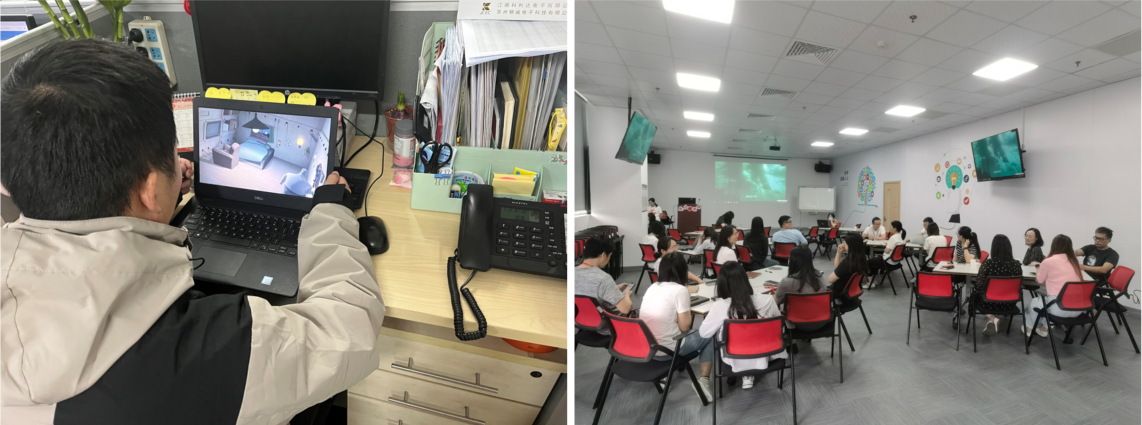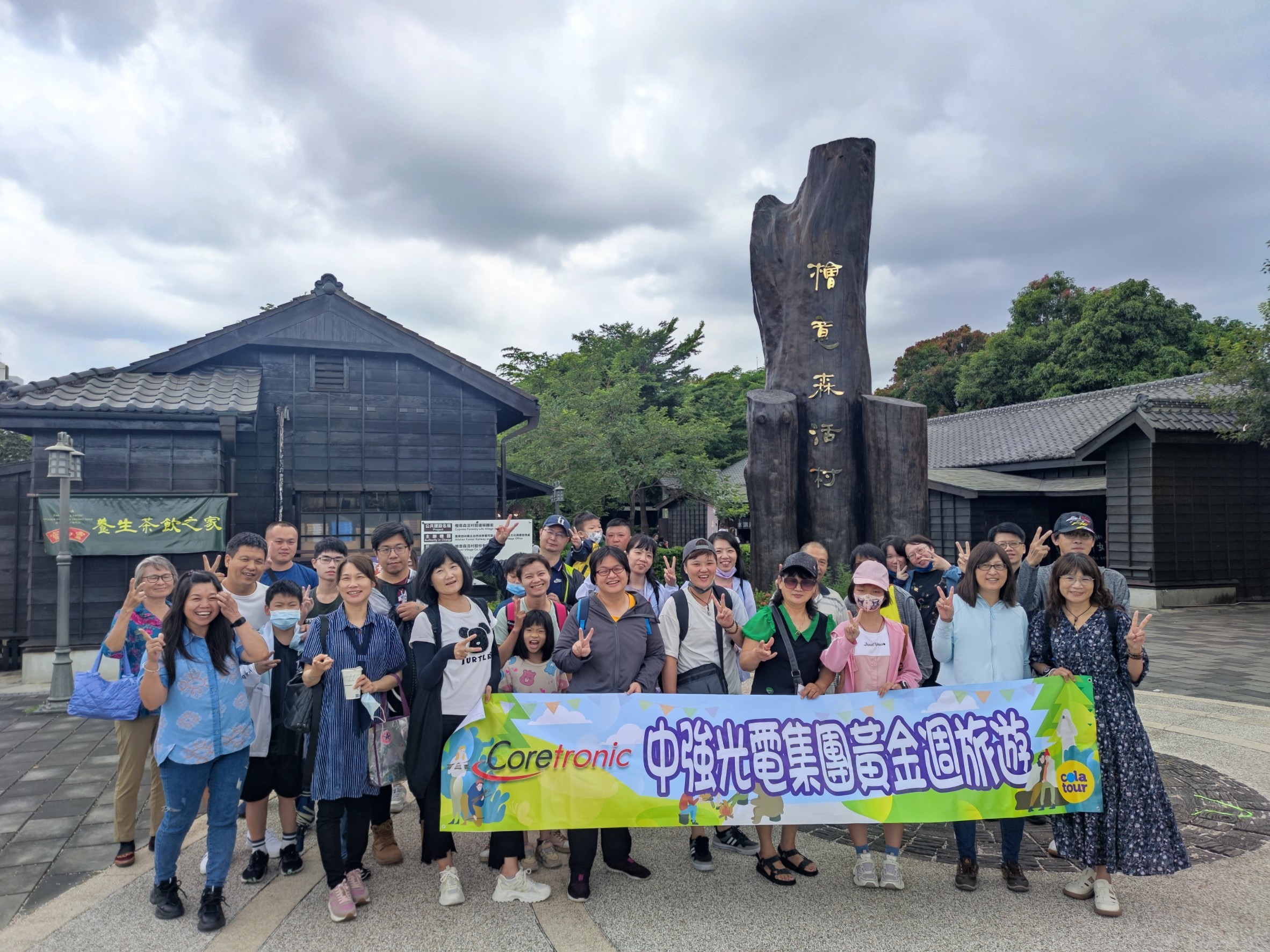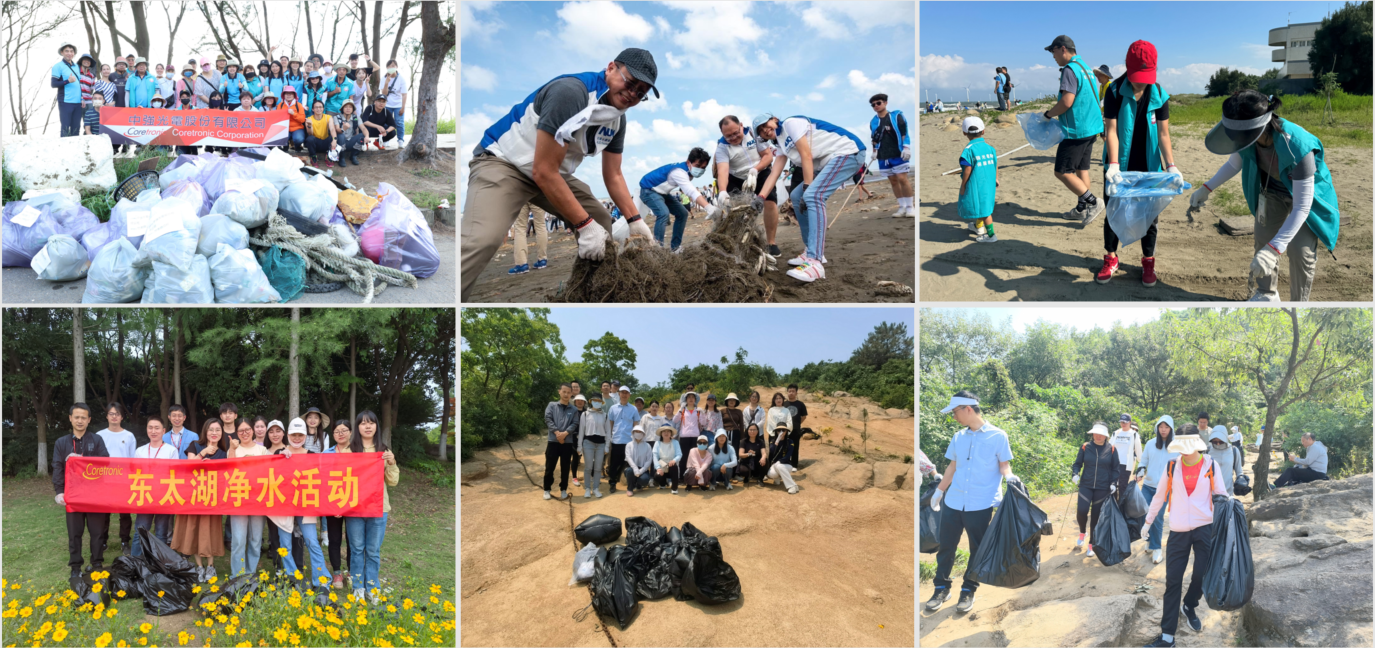Issue Date: September 30, 2025
Green Enterprise
Climate change has become one of the most concerned and impactful sustainability issues globally in recent years. Coretronic places “Environmental Sustainability 4G Force” at the core of its operations, consistently promoting eco-friendly measures and the “Green Living Practice Program”. The Company invites green partners to participate in initiatives centered around “Green Earth, Green Action, and Green Knowledge”. By raising employee awareness of energy conservation and environmental protection, and reducing water usage and CO₂ emissions from office activities, Coretronic is building green factories and aiming to expand its influence through a culture of sustainability, doing its part to mitigate the environmental impacts of climate change.
To demonstrate its firm commitment to environmental protection, Coretronic proactively signed 4 international environmental initiatives in 2024. These include the “Biodiversity Conservation and No Gross Deforestation Commitment”, through which the Company conducted assessments using the BRF (Biodiversity Risk Filter), aspiring to achieve a net positive ecological impact and meet its no-deforestation goal by 2050. In addition, Coretronic actively engaged in environmental charity activities and responded to the needs of local public agencies. For five consecutive years, the Company has adopted public restrooms and coastal areas. It also converted the benefits of its environmental campaigns into monetary donations and, for the first time, launched green travel initiatives, extending its green influence from within the organization to the broader community.

Green Earth-World Environmental Theme Days Activities
Arbor Day- 2 tree-planting events held at the China plants, adding greenery to the sites, with 17 participants.
- 2 “Coffee Grounds Planting” events held at the Wujiang plants, where coffee grounds were reused to grow succulents, with 52 participants.
Earth Day
- Turning Off Lights for One Hour: The “Turning Off Lights for One Hour” event was held for the 5 consecutive year, with participation from 8 plants across Taiwan and China, 7 elementary schools, and 115 suppliers. A total of 14,628 participations , saving 2,467 kWh of electricity and reducing carbon emissions by 1.3 metric tons , an 18% increase in carbon reduction from the previous year.
- Green Products Exchange: 548 employees in the Taiwan plants joined the Green Products Exchange event. A total of 4,267 used batteries were collected and 2,498 second-hand bags were donated to a Decathlon store in Hsinchu. Furthermore, 531 receipts were donated to the World Peace Association and the Taiwan Environmental Information Association. Proceeds from the sale of 210 second-hand books were donated to Homeless Taiwan Association and the Chinese Childrenhome & Shelter Association.
- Review Annual Event:2018, 2019, 2020, 2021, 2022, 2023, 2025
Car-Free Day
- 24 Car-Free Day events were held across the China plants, with 2,005 total participations. The event reduced fuel-powered vehicle travel by 30,543 km, cutting carbon emissions by 7.1 metric tons.
- A cycling event around Lake Tai was organized by the Wujiang plants, with 18 participants.
Cleanup Day
- All employees signed the “Company-Wide Plastic Reduction Commitment”.
- Kunshan plants organized a “Donate Preloved Items, Share Love” campaign, donating 52 clothing items and 204 books to the Kunshan Charity Foundation.
Food Day
China plants held 3 sessions of “Clean Plate Activity” during lunchtime, encouraging employees to practice food conservation by taking only what they can eat to reduce food waste. A total of 3,309 participants joined the event

Green Knowledge
Environmental Education Site Visits
- Employees and their families from the Headquarters and Chunan Plant were invited to visit Flying Cow Ranch to experience nature and participate in a series of dairy-related activities. The visit promoted the concept of environmentally friendly, low-carbon food mileage as well as knowledge and attitudes toward a healthy and balanced diet. A total of 162 participants joined, accumulating 486 hours of environmental education.
- Employees and their families from Tainan Plant 1 and 2 visited Tsou Ma Lai Recreational Farm. Through outdoor travel, DIY workshops, and ecological experience activities, participants gained an understanding of the local ecosystem and sustainability concepts. A total of 121 people participated, accumulating 363 hours of environmental education.

Environmental Education Video Promotion
- At Taiwan plants, four environmental education videos on key topics such as marine ecology, ecological conservation, and green procurement were added to the Coretronic APP. These videos were made available for employees and their families to watch, increasing awareness of environmental issues and participation in eco-friendly activities. A total of 803 viewing hours were accumulated, and a prize quiz was organized to incentivize viewing, attracting 800 participations.
- In 2024, the China plants launched an environmental education video program, offering 10 educational videos for employees to watch. The initiative aimed to enhance awareness of waste reduction, environmental protection, and nature conservation, with a total of 9,953 viewing hours accumulated.

Green Action
Eco-Friendly DIY Workshops
- Tainan Plant 1 and 2 organized an “Eco Magic Brush Workshop”, where participants repurposed yarn from old sweaters to make cleaning brushes and created food-grade bath bombs. The activity aimed to reduce resource waste and water pollution, with 30 participants taking part.
- Wujiang plants held four “Cardboard Box and Paper Cup Upcycling Workshops”, transforming waste materials into decorative items through creative reuse. A total of 39 participants joined the activities.

Low-Carbon Green Travel
- • Tainan Plant 1 and 2 jointly organized a “Hinoki Forest Green Travel Event”, allowing employees and their families to enjoy travel while minimizing environmental pollution and damage. A total of 30 participants joined the event.
- • Kunshan plants held a “Dayuwan Hiking Activity”, where employees and their families experienced the beauty of natural living through eco-friendly hiking. A total of 44 participants joined the event.

Chunan and Tainan Plant 1 have responded to the government's public restroom adoption program for 5 consecutive years, adopting 5 public restrooms in the local township office where the plants are located. In addition to providing local residents with a better restroom environment, water-soluble toilet paper is also provided to reduce waste generation. Nearly NT$60,000 was invested, benefiting 430,000 residents and reducing carbon emissions from waste by 3.7 metric tons.
Since 2021, for 4 consecutive years, Coretronic has provided straw decomposer to farmers in Hsinchu County. This allows them to use straw decomposer instead of burning straw, effectively improving air pollution problems. In 2024, the Company sponsored NT$470,000 to purchase 2,000 bottles of decomposer, which can be used for 200 hectares of rice fields, accounting for approximately 5% of the rice field area in Hsinchu County, reducing carbon emissions by 1,800 metric tons.
Mountain and Water Clean-up Events
- Protecting the Ocean: The Chunan Plant has adopted and maintained the Long Fong Fishing Port coastline for 8 consecutive years. In addition to regularly organizing beach cleanups at the port, the plant was invited for the first time by the Miaoli County Government and its customer AUO to host a “Joint Beach Cleanup Event”. Led by the Executive Vice President and supervisor of the Safety and Environment Division, the team conducted cross-district cleanups at Caota in Guanyin, Taoyuan and the Evergreen Forest Coastline in Zhunan. In 2024, 3 beach clean-up events were held, with 65 volunteer participations and 480 kg of marine debris collected. A donation of NT$40,000 was also made to the “Society of Wilderness”.
- Mountain and Water Clean-up Events: In 2024, the China plants held 3 mountain and water clean-up activities to protect natural landscapes and raise environmental awareness among employees. A total of 63 participants joined and collected 33 kg of waste.

Increase the Usage of Green Products
- In response to the green procurement policy of the Ministry of Environment and implementing the eco-friendly concept of “recyclable, low-pollution, and resource-saving”, the Company encourages suppliers to actively develop green products to improve its quality in Taiwan. The Company prioritizes the procurement of low-pollution, recyclable, resource-saving, or green building materials, self-declared or products with a lower environmental impact throughout their life cycle (from raw material acquisition to disposal).
- In 2024, the declared procurement amount from Taiwan plants reached NT$33.26 million, representing a 15% increase compared to the average of the past three years. All four Taiwan plants reported over NT$5 million in green procurement.
- In 2024, the Company procured 33,200 packages of eco-labeled toilet paper, 21,200 packages of eco-friendly hand towels, and 2,429 packages of PEFC-certified copy paper.
“Step Up” Stair Climbing Activity
- The Company installed self-developed step counters on each floor to record employees’ stair-climbing activities and their associated carbon reduction. Since the launch of the “Step Up” stair climbing activity in 2015, employees have cumulatively climbed over 240 million steps from 2015 to 2024, equivalent to climbing Taiwan’s Yushan (Jade Mountain) 13,953 times. This effort has saved approximately 3.47 GWh of electricity and reduced carbon emissions by 1,780 metric tons, equivalent to the annual carbon absorption of 4.6 Da’an Forest Parks.
- The Company distributes gift vouchers monthly and quarterly to encourage employees to take the stairs instead of the elevator, thereby saving energy and internalizing environmental awareness within the organization.

Biodiversity
Coretronic’s Taiwan and China plants are not located within any ecological conservation areas. In addition to ensuring no destruction of wildlife habitats, the Company is committed to reducing the consumption of natural resources by acting at the source. This includes fully optimizing production processes, minimizing the ecological impact of raw materials, avoiding deforestation, improving energy use efficiency, encouraging suppliers to use environmentally friendly and recyclable materials, and actively collaborating with upstream value chain partners to protect nature. Starting with the reduction of environmental damage, the Company aims to assess nature-related impacts through the TNFD (Taskforce on Nature-related Financial Disclosures) framework. This will help us achieve its biodiversity-related goals and gradually incorporate nature-related issues into business decision-making. The Company’s objective is to develop more comprehensive environmental conservation strategies and demonstrate the harmonious coexistence of technology and ecology.Biodiversity Conservation and No Gross Deforestation Commitment
To safeguard biodiversity and end deforestation, Coretronic announced its “Biodiversity Conservation and No Gross Deforestation Commitment” in 2024, officially signed and endorsed by the Chairman to demonstrate the Company’s strong dedication to biodiversity conservation. The Company actively promotes ecological protection through three major aspects of “conservation, restoration, and education”, aiming to enhance the resilience and adaptability of Earth’s ecosystems. The Company is committed to minimizing the environmental impact of its operations and drives nature conservation and environmental education through five key actions, namely “protecting biodiversity”, “implementing resource management”, “practicing green manufacturing”, “actively participating in conservation initiatives”, and “building consensus on ecological preservation”. The Company’s goal is to generate a net positive impact on ecosystems by 2050 and achieve zero deforestation, realizing a vision of synergy between technology and nature.
• Introduction of Biodiversity Risk Assessment
To better understand its dependence on and impact to biodiversity, Coretronic adopted the Biodiversity Risk Filter V2.0 (BRF) developed by the World Wildlife Fund (WWF) to evaluate physical and reputational biodiversity-related risks across operational sites within the boundaries of this Report. The assessment analyzed the geographic coordinates, industry type, and criticality of each operational site to determine their “levels of dependency” and “impact” on natural environments. It covered eight major categories, including “Provisioning Services”, “Regulating and Supporting Services - Enabling”, “Regulating Services - Mitigating”, “Cultural Services”, “Pressures on Biodiversity”, “Environmental Factors”, “Socioeconomics Factors”, and “Additional Reputational Factors”, comprising a total of 33 biodiversity-related risk indicators.
The results indicated that the Company’s biodiversity risks are primarily low to medium. Among the top five risk indicators, “pollution” showed slightly elevated risk. In response, Coretronic has established a Plastic Reduction Commitment, encouraging all employees to sign the “Company-Wide Plastic Reduction Commitment” initiative. The Company has also integrated circular economy principles into product design and development to reduce reliance on plastics. To address soil and water pollution caused by nitrogen-based fertilizers and pesticides, the Company promotes organic hydroponic vegetable cultivation and regularly sources organic agricultural products from local farmers in support of pesticide-free diets. In response to risks under “Regulating Services - Mitigating” and “Provisioning Services”, Coretronic has implemented various GHG reduction projects, water-saving initiatives, and renewable energy adoption measures to mitigate climate change and reduce the impact of extreme weather events.
Biodiversity Risk Indicators and Categories
| Rank | Top 5 Risk Indicators | Risk Categories |
| 1 | Pollution | Physical—Pressures on Biodiversity |
| 2 | Tropical Cyclones | Physical—Regulating Services - Mitigating |
| 3 | Extreme Heat | Physical—Regulating Services - Mitigating |
| 4 | Labor/Human Rights | Reputational—Socioeconomic Factors |
| 5 | Air Condition | Physical—Regulating and Supporting Services - Enabling |
Ecological Conservation Actions
- At the Wujiang plants, 2,000 native grass carp fries were released into Lake Tai. Grass carp help control the growth of aquatic plants, maintain ecological balance in the water body, and improve the aquatic ecosystem. A total of 14 participants joined this activity.
- At the Wujiang plants, new bird nests were constructed within the site to provide birds with a safe and comfortable living environment. This initiative ensures that fledglings can grow in suitable conditions, promotes biodiversity, and helps turn the site into a natural and sustainable environment.
